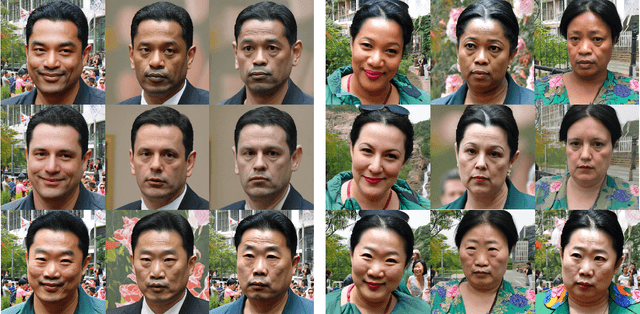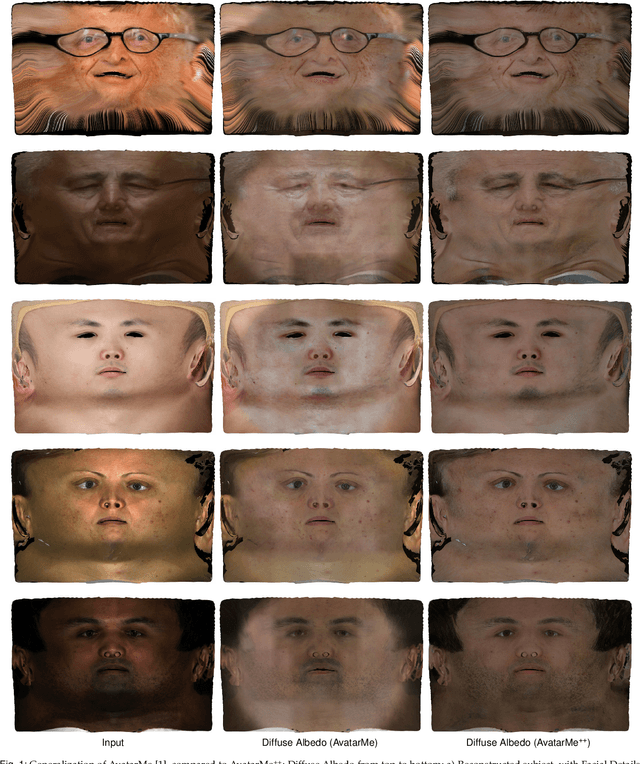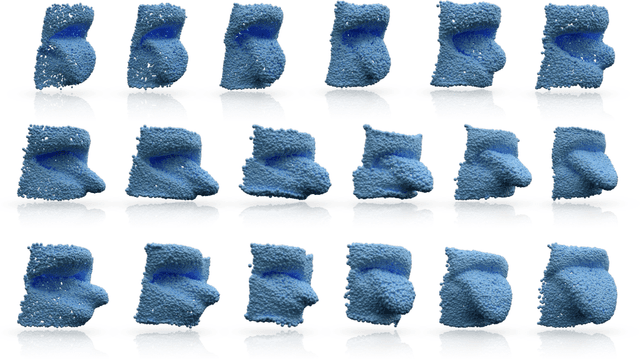Stylianos Moschoglou
SpinMeRound: Consistent Multi-View Identity Generation Using Diffusion Models
Apr 14, 2025Abstract:Despite recent progress in diffusion models, generating realistic head portraits from novel viewpoints remains a significant challenge. Most current approaches are constrained to limited angular ranges, predominantly focusing on frontal or near-frontal views. Moreover, although the recent emerging large-scale diffusion models have been proven robust in handling 3D scenes, they underperform on facial data, given their complex structure and the uncanny valley pitfalls. In this paper, we propose SpinMeRound, a diffusion-based approach designed to generate consistent and accurate head portraits from novel viewpoints. By leveraging a number of input views alongside an identity embedding, our method effectively synthesizes diverse viewpoints of a subject whilst robustly maintaining its unique identity features. Through experimentation, we showcase our model's generation capabilities in 360 head synthesis, while beating current state-of-the-art multiview diffusion models.
Text To 3D Object Generation For Scalable Room Assembly
Apr 12, 2025Abstract:Modern machine learning models for scene understanding, such as depth estimation and object tracking, rely on large, high-quality datasets that mimic real-world deployment scenarios. To address data scarcity, we propose an end-to-end system for synthetic data generation for scalable, high-quality, and customizable 3D indoor scenes. By integrating and adapting text-to-image and multi-view diffusion models with Neural Radiance Field-based meshing, this system generates highfidelity 3D object assets from text prompts and incorporates them into pre-defined floor plans using a rendering tool. By introducing novel loss functions and training strategies into existing methods, the system supports on-demand scene generation, aiming to alleviate the scarcity of current available data, generally manually crafted by artists. This system advances the role of synthetic data in addressing machine learning training limitations, enabling more robust and generalizable models for real-world applications.
Improving face generation quality and prompt following with synthetic captions
May 17, 2024



Abstract:Recent advancements in text-to-image generation using diffusion models have significantly improved the quality of generated images and expanded the ability to depict a wide range of objects. However, ensuring that these models adhere closely to the text prompts remains a considerable challenge. This issue is particularly pronounced when trying to generate photorealistic images of humans. Without significant prompt engineering efforts models often produce unrealistic images and typically fail to incorporate the full extent of the prompt information. This limitation can be largely attributed to the nature of captions accompanying the images used in training large scale diffusion models, which typically prioritize contextual information over details related to the person's appearance. In this paper we address this issue by introducing a training-free pipeline designed to generate accurate appearance descriptions from images of people. We apply this method to create approximately 250,000 captions for publicly available face datasets. We then use these synthetic captions to fine-tune a text-to-image diffusion model. Our results demonstrate that this approach significantly improves the model's ability to generate high-quality, realistic human faces and enhances adherence to the given prompts, compared to the baseline model. We share our synthetic captions, pretrained checkpoints and training code.
AnimateMe: 4D Facial Expressions via Diffusion Models
Mar 25, 2024



Abstract:The field of photorealistic 3D avatar reconstruction and generation has garnered significant attention in recent years; however, animating such avatars remains challenging. Recent advances in diffusion models have notably enhanced the capabilities of generative models in 2D animation. In this work, we directly utilize these models within the 3D domain to achieve controllable and high-fidelity 4D facial animation. By integrating the strengths of diffusion processes and geometric deep learning, we employ Graph Neural Networks (GNNs) as denoising diffusion models in a novel approach, formulating the diffusion process directly on the mesh space and enabling the generation of 3D facial expressions. This facilitates the generation of facial deformations through a mesh-diffusion-based model. Additionally, to ensure temporal coherence in our animations, we propose a consistent noise sampling method. Under a series of both quantitative and qualitative experiments, we showcase that the proposed method outperforms prior work in 4D expression synthesis by generating high-fidelity extreme expressions. Furthermore, we applied our method to textured 4D facial expression generation, implementing a straightforward extension that involves training on a large-scale textured 4D facial expression database.
Arc2Face: A Foundation Model of Human Faces
Mar 18, 2024Abstract:This paper presents Arc2Face, an identity-conditioned face foundation model, which, given the ArcFace embedding of a person, can generate diverse photo-realistic images with an unparalleled degree of face similarity than existing models. Despite previous attempts to decode face recognition features into detailed images, we find that common high-resolution datasets (e.g. FFHQ) lack sufficient identities to reconstruct any subject. To that end, we meticulously upsample a significant portion of the WebFace42M database, the largest public dataset for face recognition (FR). Arc2Face builds upon a pretrained Stable Diffusion model, yet adapts it to the task of ID-to-face generation, conditioned solely on ID vectors. Deviating from recent works that combine ID with text embeddings for zero-shot personalization of text-to-image models, we emphasize on the compactness of FR features, which can fully capture the essence of the human face, as opposed to hand-crafted prompts. Crucially, text-augmented models struggle to decouple identity and text, usually necessitating some description of the given face to achieve satisfactory similarity. Arc2Face, however, only needs the discriminative features of ArcFace to guide the generation, offering a robust prior for a plethora of tasks where ID consistency is of paramount importance. As an example, we train a FR model on synthetic images from our model and achieve superior performance to existing synthetic datasets.
FitDiff: Robust monocular 3D facial shape and reflectance estimation using Diffusion Models
Dec 07, 2023Abstract:The remarkable progress in 3D face reconstruction has resulted in high-detail and photorealistic facial representations. Recently, Diffusion Models have revolutionized the capabilities of generative methods by achieving far better performance than GANs. In this work, we present FitDiff, a diffusion-based 3D facial avatar generative model. This model accurately generates relightable facial avatars, utilizing an identity embedding extracted from an "in-the-wild" 2D facial image. Our multi-modal diffusion model concurrently outputs facial reflectance maps (diffuse and specular albedo and normals) and shapes, showcasing great generalization capabilities. It is solely trained on an annotated subset of a public facial dataset, paired with 3D reconstructions. We revisit the typical 3D facial fitting approach by guiding a reverse diffusion process using perceptual and face recognition losses. Being the first LDM conditioned on face recognition embeddings, FitDiff reconstructs relightable human avatars, that can be used as-is in common rendering engines, starting only from an unconstrained facial image, and achieving state-of-the-art performance.
FitMe: Deep Photorealistic 3D Morphable Model Avatars
May 16, 2023



Abstract:In this paper, we introduce FitMe, a facial reflectance model and a differentiable rendering optimization pipeline, that can be used to acquire high-fidelity renderable human avatars from single or multiple images. The model consists of a multi-modal style-based generator, that captures facial appearance in terms of diffuse and specular reflectance, and a PCA-based shape model. We employ a fast differentiable rendering process that can be used in an optimization pipeline, while also achieving photorealistic facial shading. Our optimization process accurately captures both the facial reflectance and shape in high-detail, by exploiting the expressivity of the style-based latent representation and of our shape model. FitMe achieves state-of-the-art reflectance acquisition and identity preservation on single "in-the-wild" facial images, while it produces impressive scan-like results, when given multiple unconstrained facial images pertaining to the same identity. In contrast with recent implicit avatar reconstructions, FitMe requires only one minute and produces relightable mesh and texture-based avatars, that can be used by end-user applications.
Relightify: Relightable 3D Faces from a Single Image via Diffusion Models
May 10, 2023Abstract:Following the remarkable success of diffusion models on image generation, recent works have also demonstrated their impressive ability to address a number of inverse problems in an unsupervised way, by properly constraining the sampling process based on a conditioning input. Motivated by this, in this paper, we present the first approach to use diffusion models as a prior for highly accurate 3D facial BRDF reconstruction from a single image. We start by leveraging a high-quality UV dataset of facial reflectance (diffuse and specular albedo and normals), which we render under varying illumination settings to simulate natural RGB textures and, then, train an unconditional diffusion model on concatenated pairs of rendered textures and reflectance components. At test time, we fit a 3D morphable model to the given image and unwrap the face in a partial UV texture. By sampling from the diffusion model, while retaining the observed texture part intact, the model inpaints not only the self-occluded areas but also the unknown reflectance components, in a single sequence of denoising steps. In contrast to existing methods, we directly acquire the observed texture from the input image, thus, resulting in more faithful and consistent reflectance estimation. Through a series of qualitative and quantitative comparisons, we demonstrate superior performance in both texture completion as well as reflectance reconstruction tasks.
AvatarMe++: Facial Shape and BRDF Inference with Photorealistic Rendering-Aware GANs
Dec 11, 2021



Abstract:Over the last years, many face analysis tasks have accomplished astounding performance, with applications including face generation and 3D face reconstruction from a single "in-the-wild" image. Nevertheless, to the best of our knowledge, there is no method which can produce render-ready high-resolution 3D faces from "in-the-wild" images and this can be attributed to the: (a) scarcity of available data for training, and (b) lack of robust methodologies that can successfully be applied on very high-resolution data. In this work, we introduce the first method that is able to reconstruct photorealistic render-ready 3D facial geometry and BRDF from a single "in-the-wild" image. We capture a large dataset of facial shape and reflectance, which we have made public. We define a fast facial photorealistic differentiable rendering methodology with accurate facial skin diffuse and specular reflection, self-occlusion and subsurface scattering approximation. With this, we train a network that disentangles the facial diffuse and specular BRDF components from a shape and texture with baked illumination, reconstructed with a state-of-the-art 3DMM fitting method. Our method outperforms the existing arts by a significant margin and reconstructs high-resolution 3D faces from a single low-resolution image, that can be rendered in various applications, and bridge the uncanny valley.
3D human tongue reconstruction from single "in-the-wild" images
Jun 23, 2021



Abstract:3D face reconstruction from a single image is a task that has garnered increased interest in the Computer Vision community, especially due to its broad use in a number of applications such as realistic 3D avatar creation, pose invariant face recognition and face hallucination. Since the introduction of the 3D Morphable Model in the late 90's, we witnessed an explosion of research aiming at particularly tackling this task. Nevertheless, despite the increasing level of detail in the 3D face reconstructions from single images mainly attributed to deep learning advances, finer and highly deformable components of the face such as the tongue are still absent from all 3D face models in the literature, although being very important for the realness of the 3D avatar representations. In this work we present the first, to the best of our knowledge, end-to-end trainable pipeline that accurately reconstructs the 3D face together with the tongue. Moreover, we make this pipeline robust in "in-the-wild" images by introducing a novel GAN method tailored for 3D tongue surface generation. Finally, we make publicly available to the community the first diverse tongue dataset, consisting of 1,800 raw scans of 700 individuals varying in gender, age, and ethnicity backgrounds. As we demonstrate in an extensive series of quantitative as well as qualitative experiments, our model proves to be robust and realistically captures the 3D tongue structure, even in adverse "in-the-wild" conditions.
 Add to Chrome
Add to Chrome Add to Firefox
Add to Firefox Add to Edge
Add to Edge